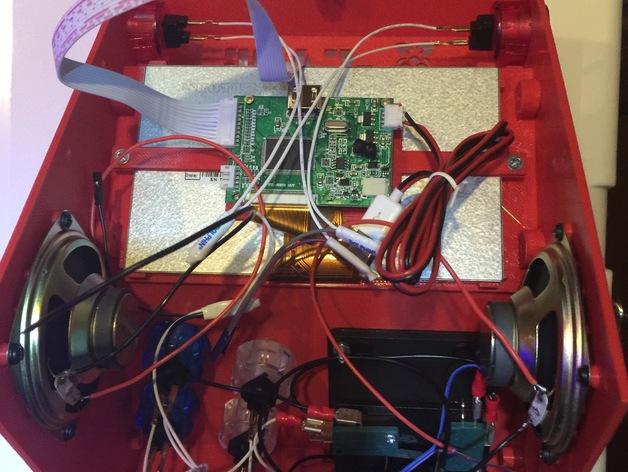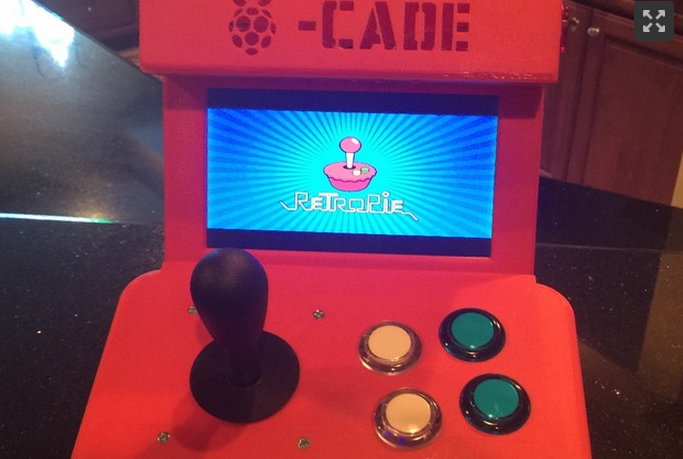As technology progresses faster and faster, giving us more and more in the areas of 3D printing, computing, and entertainment, we have more than we ever could have dreamed of at our fingertips–and at rapid speed. There are numerous machines and technologies that die hard though, and the video arcade game would be one.
We see numerous creative projects coming out with gamers and 3D printing enthusiasts making fun devices like varying arcade games, 3D printed joysticks, portable 3D printed gaming for older systems, and more.
Most gamers, regardless of age or rank, are loathe to see PacMan or Space Invaders go. So, they’ve been carried along into the new millennium and practically everybody seems to enjoy seeing them integrated into fun new projects that are possible due to the latest technology, in an amusing mix and match in 3D printed arcade cabinets.
 Another great example would be the Pi-Cade, made by Timothy Belcher, who was inspired greatly by the popular works of the team at Adafruit. He made a 3D printed arcade cabinet for the Raspberry Pi 2 after seeing a similar project, the Cupcade, which they captioned as being small enough to fit into your bag.
Another great example would be the Pi-Cade, made by Timothy Belcher, who was inspired greatly by the popular works of the team at Adafruit. He made a 3D printed arcade cabinet for the Raspberry Pi 2 after seeing a similar project, the Cupcade, which they captioned as being small enough to fit into your bag.
He also gained inspiration from Retrobuilt, and between the two he was able to get the design and size that work for his playing requirements, as well as accompanying aesthetics.
“I thought the Cupcade concept was great, but with a tiny two-inch screen, the playability may be limited,” said Belcher. “Similarly, Retrobuilt is a nice cabinet, but I thought the footprint could be much smaller and still remain very comfortable to use and play. And of course, I wanted a 3D printed version.”
Made for the desktop, Belcher’s arcade, available on Thingiverse, features:
- Seven-inch screen
- Real arcade controls
- Amplifier
- Three-inch stereo speakers
- Retropie system using EmulationStation
 You’ll want to 3D print all the files and choose your marquis option, and after that you will want to assemble the panels, connect the appropriate cables, and order the appropriate components, colors, and monitor from Adafruit, all outlined on Thingiverse, along with the files for the joystick and buttons.
You’ll want to 3D print all the files and choose your marquis option, and after that you will want to assemble the panels, connect the appropriate cables, and order the appropriate components, colors, and monitor from Adafruit, all outlined on Thingiverse, along with the files for the joystick and buttons.
You will also need to find the following:
- Raspberry Pi model 2
- WiFi dongle
- SD card and plug
Still a work in progress, keep an eye for updates. Belcher also advises to those 3D printing this piece that with the largest component being 240 x 180 mm, you will need a large print bed that is ‘dialed in’ and well-leveled.
With detailed instructions available from Belcher, along with the Sketchup files for editing, it’s pretty simple to make–and nearly everything can be found from Adafruit too. Belcher also recommends the tutorial from Adafruit, below, which gives a lot of great tips on building the control panel, joystick, buttons, and more.
Is this a 3D printing project that interests you? Have you made any similar devices? Discuss in the 3D Printed Pi-Cade forum thread over at 3DPB.com. Check out some Pac-Man play in the video below.
Subscribe to Our Email Newsletter
Stay up-to-date on all the latest news from the 3D printing industry and receive information and offers from third party vendors.
You May Also Like
Blue Laser Firm NUBURU Explores Strategic Alternatives Amid NYSE Compliance Challenges
In a strategic move reflecting the current macroeconomic landscape, NUBURU, Inc. (NYSE American: BURU), a pioneer in industrial blue laser technology, has announced its decision to explore a wide array...
Flexible Wireless Temperature Sensor Made with 3D Printing
Researchers from the University of Glasgow, University of Southampton, and Loughborough University have developed an innovative flexible temperature sensor utilizing microwaves and 3D printing technology. As detailed in an article...
3D Printing Laser Maker NUBURU Faces NYSE American Compliance Challenge
NUBURU (NYSE American: BURU), known for its innovative high-power and high-brightness industrial blue laser technology, has received a non-compliance notice from the NYSE American, formerly the American Stock Exchange (AMEX)....
3D Printing Resilience: the Case of Fiber Lasers
Since at least 2020, additive manufacturing (AM) has become more and more synonymous with the concept of supply chain resilience. In 2024, there is almost guaranteed to be a striking...
































